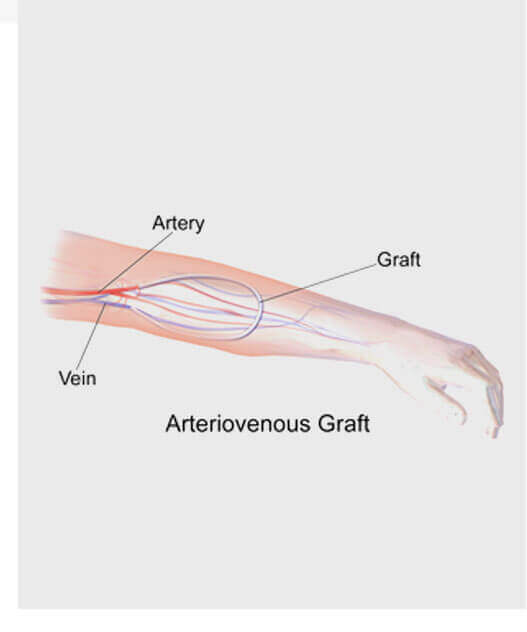Access – access means to reach. In order to perform dialysis, we first need to reach the blood stream of the patient. In hemodialysis, this access is established through any one of the following 3 ways:
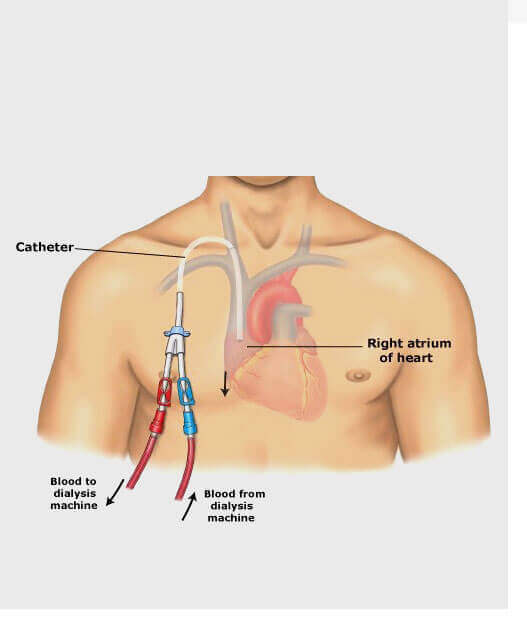
Dialysis catheter
A dialysis catheter is a soft tube placed either in the neck or leg. It is a temporary access as it has a short life. This option is considered only for sudden cases of kidney failure who require immediate and short term dialysis for example - cases of acute kidney injury. Such patients may require few sessions dialysis and then their natural kidneys may take over its function again. However, in case of chronic kidney disease (CKD), the natural kidneys cannot take over their function and hence, they require lifelong dialysis. Such patients are not candidates for dialysis catheters rather they need an A V fistula.
Tips for dialysis catheter care:
- Keep your catheter dressing dry (avoid showering)
- Keep your dressing clean and make sure your dressing is changed at each dialysis session by your Nurse or dialysis technician.
- Never open your catheter or expose it to open air.
- Avoid wearing tight clothing.
- In case of occurrence of fever or chills or any bleeding from the catheter site, contact your dialysis centre immediately.
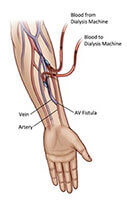
A V Fistula
This is a route made surgically by joining an artery to a vein. Construction of A V fistula is a minor surgery which is done by a Vascular Surgeon. Once it is constructed, it cannot be used immediately for dialysis. It needs 4 – 6 weeks to mature (blood vessels need to become strong enough to allow a rapid flow of blood through it).
Exercising your arm before and after surgery may encourage a fistula’s development and maturation. Once mature, a fistula is easier for the dialysis staff to puncture in order to get a good blood flow needed for dialysis.
Below are some exercise techniques that may be used to help develop your fistula.
Ball Squeeze
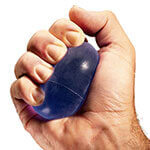
As soon as the pain from surgery has subsided, start forearm exercises by squeezing a “stress” ball. Squeeze and release rapidly for 10 minutes, 6 times a day. Additionally, you may use your other hand to squeeze the bicep of your fistula arm. This improves and facilitates early maturation.
Clothes-Pin Grasp
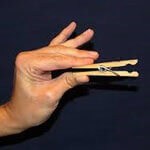
Using a clothespin, squeeze open and allow to close repeatedly for 5 minutes, 6 times daily.
Upper Arm Fistula Exercises - Hammer Curl
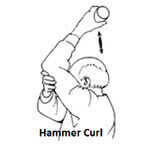
An effective way to exercise an upper arm fistula, (a fistula created above your elbow) is to perform arm curls with a weight. To perform a “hammer curl”, take a 1 to 3 pound weight in the arm your fistula was created in and hold the weight as shown in this picture. Pump your arm up and relax down slowly for 10 minutes, 6 times a day.
Finger Tip Touches

Lastly, another good exercise to help strengthen and develop your fistula are finger tip touches. Touch each finger to the tip of your thumb, opening up your hand after each touch. Touch tips to thumb repeatedly for 5 minutes, 6 times a day.

Upper Arm Fistula Exercises - Bicep Curl
Another easy exercise is the bicep curl. A useful, household weight is a regular can of vegetables. Holding the can, curl your arm slowly up and down for 10 minutes, 6 times daily.
After Surgery of fistula
Once your fistula is constructed, you need to feel it and hear it. You will feel vibrations coming from it and will hear a rushing sound (which can be heard if you take your hand near to your ear).
You need to FEEL this and LISTEN to this EVERYDAY, WITHOUT FAIL. This ensures your fistula is working well.
After your AV Fistula surgery till its puncturing, if there is:
- Absence of the vibration and rushing sound
- If you notice redness, swelling, pus
- Wound stitches gone apart
- Fingers becoming cold or blue
- If you have fever
then, contact your surgeon immediately. This may indicate a failure of that A V fistula and a new one may need to be constructed.
After your A V fistula has matured and it is ready for puncturing, you need to take following care:
- Avoiding tight clothes, jewellery, watches or anything that may put pressure on your arm
- Avoid sleeping on top of your arm
- Avoid carrying heavy materials including shopping bags and purses as they can compress your veins
- Keep your fistula arm clean, wash it after you arrive at your dialysis centre.
- Strictly do not allow.
- BP check up
- IV injections
- Blood check up from your fistula arm.
If there is any pain, swelling or redness around your fistula, it may be an infection and hence notify this immediately to your dialysis centre.
A V fistula is the best choice for dialysis access as it lasts much longer than dialysis catheter or graft. It can work even for decades if handled with precautions and care. It is the most preferred access as it has less chances of infection.
Graft
A graft is a surgical connection of an artery and a vein by a synthetic tube. In case your veins are poor then a fistula may not be possible and in such cases a graft remains the next choice. It requires lesser time than A V fistula to develop. It can be used after 2 weeks of construction.
Comparison between dialysis catheter, fistula and graft.
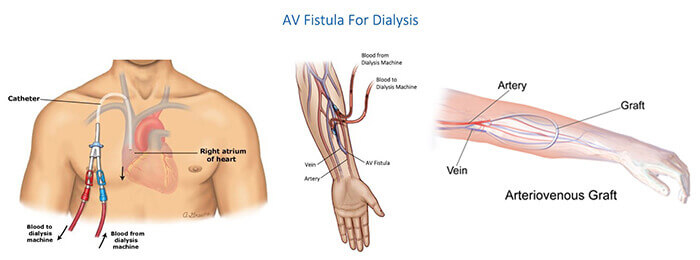
Dialysis catheter |
Fistula |
Graft |
Least preferred choice |
Best choice |
If veins are poor, this is second best alternate to fistula |
Short life (depending on the type of catheter, life can be between 1 month to 1 year) |
Long lasting (can last for more than 10 years) |
Fairly long life (3 – 5years) |
High chances of infection |
Least chances of infection |
Lower chances of infection |
Patient unfriendly |
Patient friendly |
Patient friendly |
